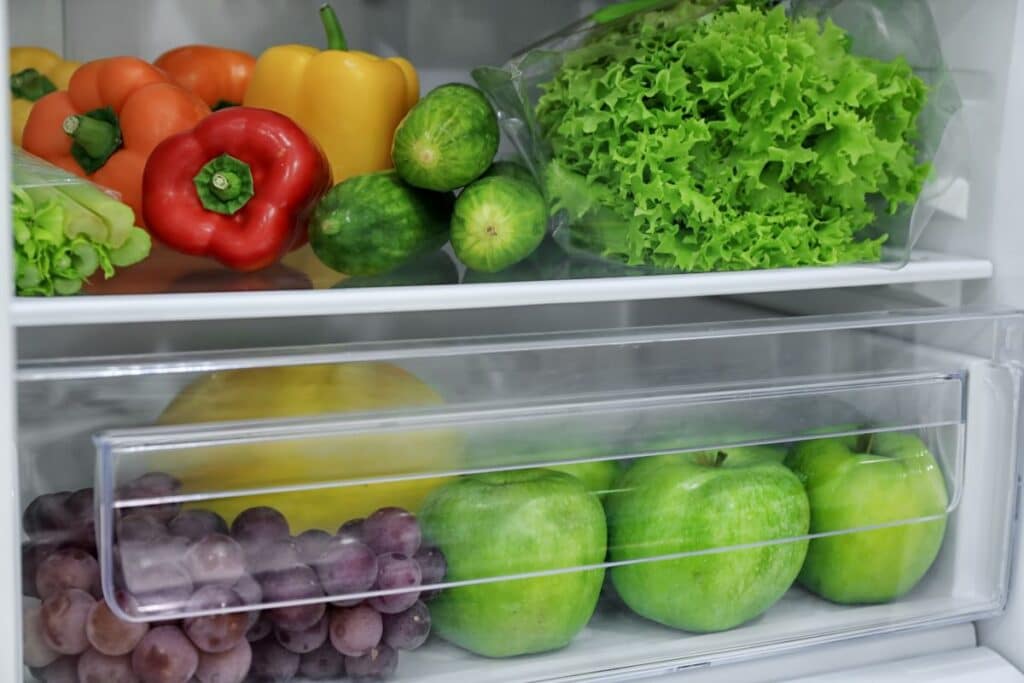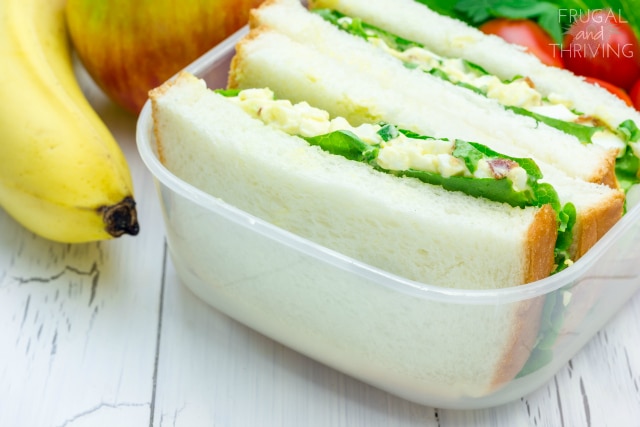Printable Fruit, Vegetable and Herb Storage Guide
This website may earn commissions from purchases made through links in this post.
Wasted food that ends up in the bin without being eaten makes up an alarmingly large proportion of the average grocery bill. Save money by storing your produce well. Here’s a printable fruit and vegetable storage chart.

When food goes to waste, it’s the same as throwing your hard-earned money in the bin.
On average, Australians throw away 20% of food purchased. If your average weekly grocery spend is $250 and 20% goes in the bin then you’re throwing away $2,600 a year!!
One of the reasons fruit and vegetables go to waste is because they deteriorate before they are used.
While good menu planning ensures you aren’t buying food that you’re not going to use, proper storage of fruits and vegetables ensures what you do buy doesn’t go bad before you eat it.
Save Money on the Groceries eBook

For more ways to meal plan and save money on groceries, check out the eBook Plan Cook Save: How to Eat Well When Money is Tight and Time is Short.
*Learn how to set the right grocery budget for your circumstances.
*Find out the easiest and quickest way to reduce the grocery bill.
*Discover a meal planning strategy that will only take you a couple of minutes a week but will save you hours.
Today’s post is a downloadable, printable PDF guide to storing fruit and vegetables. Print it out and stick it to your fridge or place it in your household binder so you can refer to it when you’re unpacking the fruit and veg.
If your fruit and vegetables do end up looking a little worse for wear, don’t throw them out just yet, see if you can revive them first.
And if you’ve bought extra fruit and vegetables or you don’t use what you’ve bought for whatever reason, check out ways on how to use them up so they don’t go to waste or freeze them for later.
You might also like: Frugal Fruit and Vegetables Guide
What temperature should I store fruit and vegetables?
When people suggest storing fruits and vegetables at ‘room temperature’ what does that mean? Which fruits and vegetables should be stored in the fridge and which ones do people recommend never storing in the fridge?
First, let’s start with your fridge and how cold it should be.
According to food safety guidelines, your fridge temperature should be set at or below 5°C. Different parts of your fridge will be at different temperatures (the fridge door is usually warmer), so it might be a good idea to get a thermometer to test how cold each section of your fridge is.
Most fruit and vegetables benefit from being stored in the fridge in humid conditions, particularly green vegetables and leafy vegetables.
Plastic is great for keeping fruit and vegetables humid in the fridge, but as single-use plastic is bad for the environment, either reuse the plastic produce bags as much as you can before red-cycling them or opt for non-plastic alternatives like wrapping vegetables in clean, damp tea towels, use containers with tight-fitting lids, or use reusable silicone pouches.
Fruit and Vegetables that don’t need to go in the fridge
Fruit and vegetables that can be stored at room temperature include the following (although many like tomatoes, stone fruit, avocados etc. I ripen on the bench and then store in the fridge once ripe so they last longer. Also, once cut, they need to go into the fridge):
- stone fruits
- bananas
- pears (until ripe)
- apples
- avocados (until ripe)
- tomatoes (until ripe)
- potatoes
- uncut pumpkin
- onions
- garlic
- most tropical fruit (until ripe)
- citrus fruit
Cold v Cool Storage
Vegetables like potatoes, sweet potatoes, onions, garlic, and uncut pumpkin benefit from being stored in a cool, dry place. That means, well ventilated in the pantry (not in plastic) at 6°C-10°C.
For tropical fruits and tomatoes, they are best stored on the bench or in a fruit bowl at temps up to 22°C.
When storing fruit and vegetables at room temperature, it’s important to take them out of plastic bags so they can ‘breathe’ as this will extend their shelf-life. Also, store ethylene emitters separate from ethylene-sensitive fruits (see below).
And if you’re like me and you live in a very hot and humid environment that is waaay over the recommended temperatures, you might want to store some of these items in the fridge anyway. For example, our apples last longer if I store them in the fridge.
For details on how to store individual fruits, download the chart below.
You might also like: Frugal Kitchen Hacks That Save Money
The Ethylene Factor
Some fruits naturally release ethylene gas while some vegetables are ethylene-sensitive. Pair these together and you will hasten ripening and decay. If you want your produce to last longer, it’s important to keep these ethylene-emitting and ethylene-sensitive fruit and veg apart.
Ethylene-emitting fruits include:
- apples
- bananas
- avocados
- tomatoes
- pears
- mangos
- kiwi fruit
- nectarines
- peaches
- passion fruit
- rockmelon
- honeydew melon
- plums
Ethylene-sensitive vegetables include:
- Broccoli
- Carrots
- Beans
- Cabbage
- Cauliflower
- Cucumbers
- Lettuce and other leafy greens
- Fresh herbs
- Beans
- Eggplant
- Peas
- Capsicum
- Sweet potatoes
- Watermelon
- Oranges
Most of the ethylene emitters don’t need to be stored in the fridge unless they are ripe or it’s hot and humid. They can either be stored on a shelf or in a separate crisper if your fridge has two drawers.
You might also like: Printable What’s In Season Guides
Download the fruit and vegetable storage chart
You can download and print the PDF fruit and veg storage chart here or click on the picture below.









The fridge is actually a great way of dehydrating some veg. Have you ever found that mushroom paper bag hidden in the fridge with disreputable DRY things in it.Don’t throw them away,take the bag out of the fridge and put in the sunlight for about a week this will complete the dehydration and then store in a jar . You can keep them in the fridge still if you want.
Whole unpeeled carrots (not in the crisper) will dry too.
But a vegetable has to be completely unusable to not get used in my house.Even clean veg peelings,pea pods if you have them all top cuttings,root ends of spring onions.Just save them up in the freezer then put into a pot and make stock then freeze in whatever quantity you want. Any meat bones (that haven’t been chewed) including chicken carcases bacon rinds etc. roast them (it intensifies the flavour)and then use as a base for stock with veg scraps.
They are some great tips for using up vegetables, thanks!
Hi, this may seem like a really stupid question but will this list be the same all over the world? Living in the UK our temperatures are different to yours, can I still use it do you think?
Cxx
Yep. And it will probably be easier in the UK as your temps are cooler (unless you have central heating on). I live in the sub-tropics so I have to store practically everything in the fridge in summer.